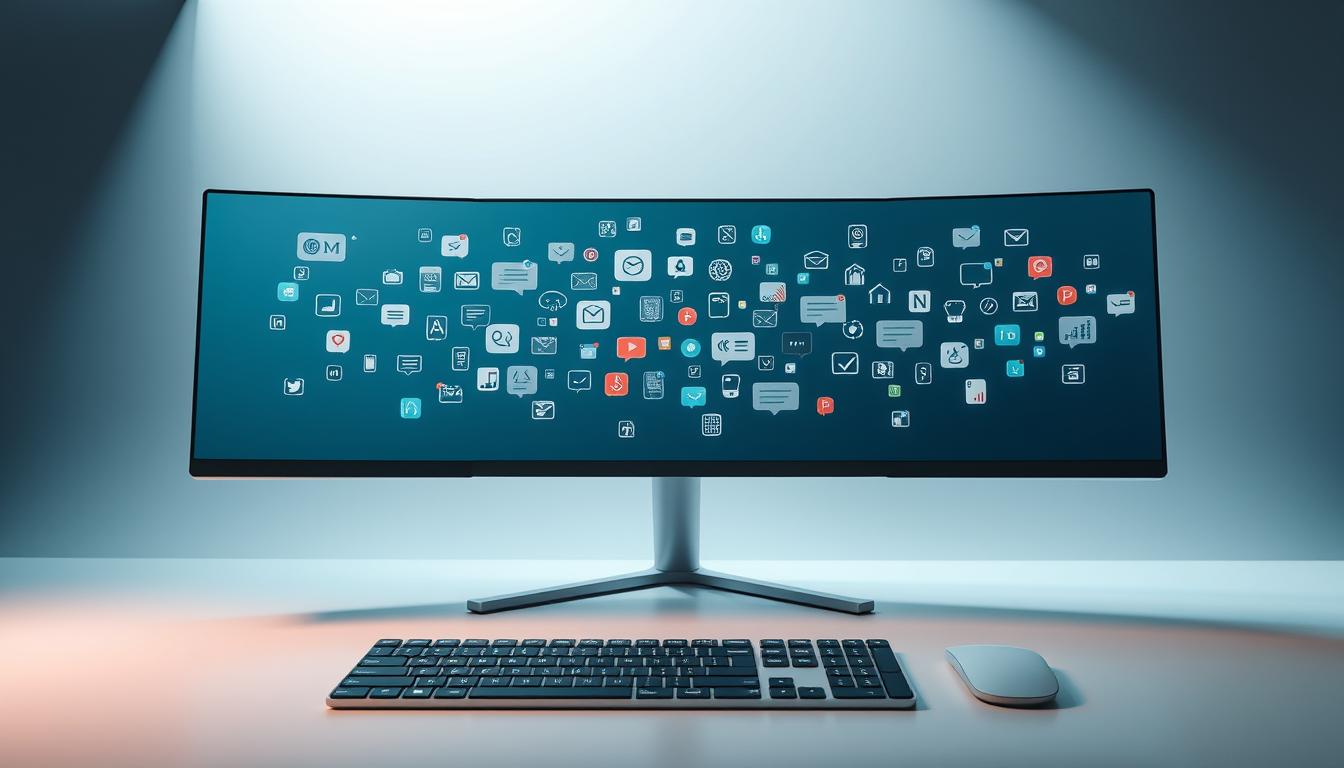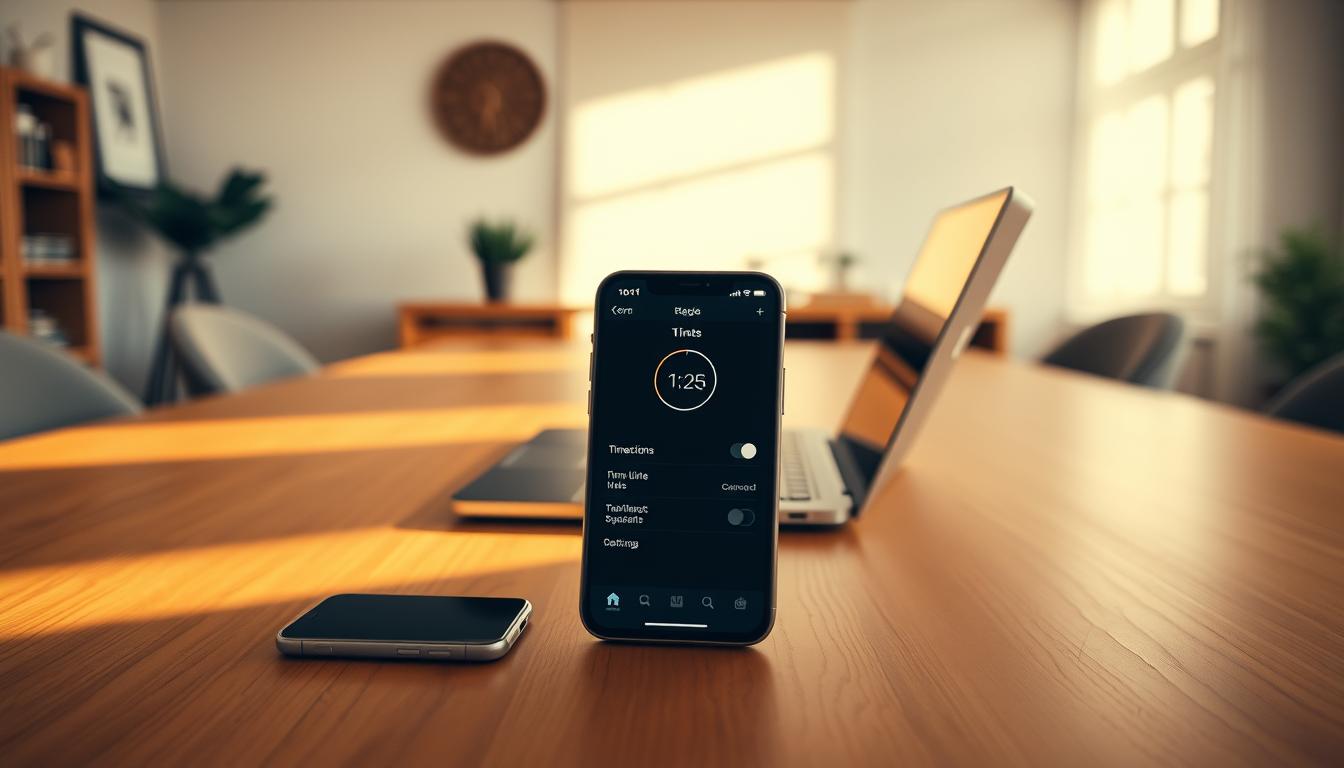Digital Detox Challenge: 7-Day Plan to Cut Screen Time

In today’s world, technology is everywhere. 85% of American adults use the internet daily, and the average person spends over four hours on mobile devices. This constant connection can take a toll on your well-being.
Many people use their devices within an hour of bedtime, which can disrupt sleep patterns. Over time, this leads to increased anxiety and lost productivity. It’s clear that finding a balance is essential for a healthier life.
This 7-day framework offers a gradual and sustainable way to reduce your reliance on technology. It’s designed to help you reclaim your time and focus on what truly matters. With a non-judgmental approach, you can make flexible adjustments that fit your lifestyle.
By taking small steps, you can experience the benefits of a digital detox. Improved sleep, reduced stress, and better productivity are just a few of the rewards. Let’s start this journey together and create a healthier relationship with technology.
Key Takeaways
- 85% of American adults use the internet daily.
- The average person spends over four hours on mobile devices.
- Using devices before bed can disrupt sleep patterns.
- A gradual approach helps create sustainable habits.
- Flexible adjustments make the process easier to follow.
- Improved sleep and reduced stress are key benefits.
What is a Digital Detox and Why Should You Try It?
Modern life is deeply intertwined with technology, often leaving little room for mental clarity. A digital detox is about intentionally reducing your tech use, not eliminating it entirely. It’s a way to break free from the constant pull of notifications and reclaim your focus.
Neuroscience explains why this is so hard. Every notification triggers a dopamine loop, making you crave more. Over time, this can lead to a problematic relationship with your devices. Studies show that 50% of teens feel their parents are addicted to their smartphones, highlighting how widespread this issue is.
The benefits of a detox are clear. Improved focus, better sleep quality, and reduced stress are just a few. You’ll also reclaim lost time and cultivate mindfulness, allowing you to connect more deeply with the world around you.
Research supports this. A study in JAMA Pediatrics links social media to internalizing behaviors, while the Royal Society found that 70% of UK youth report social media harms their mental health. Additionally, the WHO links inactivity to global mortality risks, emphasizing the need for balance.
Contrasting healthy and problematic device use is key. A healthy relationship with technology enhances life, while an unhealthy one drains it. By taking small steps, you can create a sustainable balance that works for you.
How to Prepare for Your 7-Day Digital Detox
https://www.youtube.com/watch?v=B739ez1PPWo
Taking control of your tech habits starts with preparation. A little planning can make the process smoother and more effective. Here’s how to set yourself up for success.
First, create an environment that supports your goals. Designate physical storage stations for your devices. This helps reduce the temptation to pick them up unnecessarily. For example, keep your phone in a drawer during meals or work hours.
Next, focus on emotional preparation. Journaling about your current feelings toward tech can provide clarity. Are you using it to escape stress or boredom? Understanding your motivations is a crucial step toward change.
Social preparation is equally important. Inform key contacts about your reduced availability. Let them know you’ll be less responsive during this time. This minimizes interruptions and sets clear boundaries.
"Preparation is the key to success. By setting clear boundaries, you create a foundation for lasting change."
On the tech side, enable screen time tracking on your iOS or Android device. This helps you monitor usage and identify patterns. Knowing where your time goes is the first step to reclaiming it.
Finally, mentally prepare by identifying high-risk situations or triggers. Do you reach for your phone when bored or stressed? Recognizing these moments allows you to plan alternatives.
| Preparation Type | Action |
|---|---|
| Environmental | Create device storage stations |
| Emotional | Journal current tech feelings |
| Social | Inform key contacts |
| Tech | Enable screen time tracking |
| Mental | Identify high-risk situations |
By taking these steps, you’ll be ready to tackle the next seven days with confidence. Preparation ensures you’re in control, not your devices.
Day 1: Track Your Screen Time
Understanding your tech habits is the first step toward change. Before making adjustments, you need to know where your time goes. Tracking your usage helps you identify patterns and areas for improvement.
Monitor Your Usage
Start by using built-in tools on your device. Both iPhone and Android offer features that track your screen time and app usage. These tools provide detailed insights into how you spend your hours each day.
Compare work-related and leisure app usage. This helps you see if certain apps are draining more time than they should. Identifying these "vampire apps" is crucial for making informed changes.
Awareness of Your Starting Point
Establish baseline metrics for all your devices. This gives you a clear picture of your current habits. Knowing your starting point makes it easier to measure progress over time.
Journal your emotional responses to the data. Do you feel stressed or surprised by your usage? This reflection helps you understand the way technology impacts your daily life.
- Use native tracking tools for accurate insights.
- Identify apps that consume disproportionate time.
- Set a baseline to measure future progress.
- Reflect on how your usage makes you feel.
Day 2: Tame Notifications

Your phone buzzes, and instantly, your focus shifts—this is the power of notifications. According to an APA survey, 86% of people constantly check their devices, often interrupting their workflow. Today’s goal is to minimize these distractions and reclaim your focus.
Turn Off Non-Essential Alerts
Start by categorizing your notifications into critical and optional. Critical alerts might include messages from family or work-related updates. Optional ones, like social media pings, can wait. Turning off non-essential alerts reduces unnecessary interruptions.
Batch process non-urgent communications. Instead of responding to every message immediately, set specific times to check your apps. This approach helps you stay productive without feeling overwhelmed.
Minimize Distractions
Implement a notification triage system. Prioritize alerts based on urgency and importance. For example, mute group chats or promotional emails that don’t require immediate attention.
Use Do Not Disturb schedules strategically. Enable this feature during work hours or before bed to create uninterrupted blocks of time. This simple step can significantly reduce stress and improve your focus.
Finally, measure the reduction in phone pick-ups. Track how often you reach for your device after making these changes. This data will help you see the impact of your efforts and stay motivated.
| Action | Benefit |
|---|---|
| Categorize notifications | Reduce interruptions |
| Batch process communications | Increase productivity |
| Use Do Not Disturb | Create focused time blocks |
| Measure phone pick-ups | Track progress |
By taming your notifications, you’ll take a significant step toward a healthier relationship with tech. This small break from constant alerts can lead to a calmer, more focused you.
Day 3: Create Phone-Free Zones and Times
Setting boundaries with your devices can transform your daily routine. By designating specific areas and periods without tech, you can reclaim your focus and improve your relationship with your phone. This step is about creating intentional spaces where you can disconnect and recharge.
Designate Areas Without Devices
Start by identifying key areas in your home where devices are not allowed. The bedroom is a great place to begin. Keeping your phone out of this space can improve sleep quality and create a calming environment. According to WHO guidelines, reducing screen time before bed supports better physical and mental health.
Meal times are another opportunity to connect without distractions. Use this time to engage in meaningful conversations or enjoy offline activities like reading or journaling. These small changes can make a big difference in your daily routine.
Establish Clear Boundaries
Gradually expand your tech-free zones to other areas, like your living room or workspace. Physical storage solutions, such as locked boxes or designated drawers, can help reinforce these boundaries. This approach ensures your devices are out of sight and out of mind during specific periods.
Involving your family can make this process easier. Create a family contract that outlines shared goals and expectations. This collaborative effort fosters accountability and strengthens your relationship with both your loved ones and your tech.
| Zone | Action |
|---|---|
| Bedroom | Keep devices out for better sleep |
| Dining Area | Focus on meals and conversations |
| Living Room | Designate tech-free relaxation time |
| Workspace | Limit distractions for productivity |
By creating phone-free zones and times, you’ll take a significant step toward a healthier balance. These boundaries help you focus on what truly matters and rediscover the joy of offline activities.
Day 4: Set App Time Limits

Managing your app usage is a powerful way to regain focus. Many of us spend countless hours on apps without realizing it. Today, you’ll learn how to take control of your tech habits by setting intentional limits.
Use Built-In Tools to Limit Usage
Both iOS and Android offer tools to help you manage your screen time. iOS has Screen Time, while Android provides Digital Wellbeing. These features let you track and restrict app usage effectively.
Start by grouping apps by priority levels. For example, work-related apps can have higher limits, while social media can be restricted. This way, you ensure essential tasks aren’t interrupted.
Practice Conscious Control
Implement a progressive reduction strategy. Cut your app usage by 25-50% initially. This gradual approach makes the transition easier and more sustainable.
For accountability, set password-protected limits. This prevents you from bypassing the restrictions you’ve set. Pair this with alternative activity planning, like reading or exercising, to fill the time you’d usually spend on digital devices.
| Strategy | Benefit |
|---|---|
| Use built-in tools | Track and restrict app usage |
| Group apps by priority | Focus on essential tasks |
| Progressive reduction | Ease into new habits |
| Password-protected limits | Ensure accountability |
| Plan alternatives | Replace screen time with offline activities |
By setting app time limits, you’ll take a significant step toward a healthier relationship with tech. This practice helps you stay focused, productive, and in control of your time.
Day 5: Take a Social Media Break
Breaking free from social media’s grip can open the door to a more present and fulfilling life. Today, you’ll take a break from the endless scroll and focus on what truly matters. This step is about reclaiming your time and improving your mental health.
Delete or Log Out of Time-Consuming Apps
Start by removing or logging out of apps that consume most of your time. Temporary deletion can help you reset your habits without feeling overwhelmed. If permanent removal feels too drastic, consider a short-term social media fast to test the waters.
Experience Life Without the Scroll
Use this break to explore alternative activities. Journaling, reading, or spending time outdoors can fill the void left by social media. Track your mood during this period to see how your mental health improves without constant scrolling.
- Choose temporary deletion or permanent removal based on your comfort level.
- Experiment with social media fasting techniques to find what works for you.
- Manage FOMO by focusing on meaningful offline connections.
- Use alternative communication channels like calls or texts to stay connected.
- Monitor your mood to see the positive impact of this detox challenge.
By stepping away from social media, you’ll gain clarity and rediscover the joy of living in the moment. This digital detox helps you create a healthier balance between online and offline life.
Day 6: Replace Screen Time with Offline Activities

Rediscovering the joy of offline moments can transform your daily routine. By focusing on real-world experiences, you can create a healthier balance and reconnect with what truly matters. This step is about finding engaging alternatives to tech and rediscovering the benefits of offline living.
Plan Engaging Alternatives
Start by exploring a variety of activities that fit your interests. Create an activity matrix that includes physical, creative, and social options. For example, try hiking, painting, or joining a local club. These activities not only fill your hours but also enrich your life.
Relearning boredom tolerance is key. Instead of reaching for your phone, embrace moments of stillness. This practice helps you appreciate the simplicity of offline activities and fosters creativity.
Rediscover Offline Interests
Engage with your community through volunteer work or group projects. These experiences build connections and provide a sense of purpose. Skill-building projects, like learning to cook or garden, can also be rewarding and practical.
Family activity planning templates can help you organize shared experiences. Whether it’s a game night or a weekend outing, these moments strengthen bonds and create lasting memories.
- Physical: Try sports, yoga, or dancing.
- Creative: Explore painting, writing, or crafting.
- Social: Join clubs, volunteer, or host gatherings.
- Skill-building: Learn a new language or instrument.
- Family-focused: Plan outings or game nights.
By replacing screen time with offline activities, you’ll experience the benefits of a more balanced life. Improved sleep, enhanced creativity, and stronger relationships are just a few of the rewards waiting for you.
Day 7: Reflect and Plan for the Future
Reflecting on your journey can help you build lasting habits. The final day of your plan is about reviewing your progress and creating a sustainable balance with technology. This step ensures the benefits you’ve gained continue to enhance your life.
Review Your Progress
Start by comparing your data from Day 1 to Day 7. Look at how your habits have changed. Have you reduced unnecessary tech use? Improved your sleep quality? This analysis helps you see the tangible results of your efforts.
Use habit stacking techniques to reinforce positive changes. For example, pair checking your phone with a mindful breathing exercise. This creates a routine that supports your goals.
Create a Sustainable Tech Balance
Develop a customizable tech agreement to guide your future use. Include specific boundaries for work and personal time. This ensures you maintain a healthy relationship with your devices.
Plan for potential relapses by identifying triggers and creating strategies to overcome them. Monthly check-ins can help you stay on track and adjust your approach as needed.
"Sustainability comes from intentional habits and consistent reflection. Small adjustments lead to lasting change."
| Strategy | Benefit |
|---|---|
| Comparative data analysis | Track progress and identify improvements |
| Habit stacking | Reinforce positive changes |
| Customizable tech agreement | Set clear boundaries for tech use |
| Relapse prevention planning | Stay on track during challenges |
| Monthly check-ins | Adjust and refine your approach |
By reflecting and planning, you’ll create a sustainable balance that supports your life and work. This final step ensures the benefits of your digital detox challenge last long after the seven days are over.
Take Control of Your Digital Life
Taking charge of your relationship with technology can lead to a more balanced and fulfilling life. To maintain this balance, consider implementing long-term strategies like 30-60-90 day maintenance plans. These help you gradually build healthier habits without feeling overwhelmed.
Workplace policies can also play a key role. Encourage digital hygiene at work by setting clear boundaries for device use. This fosters productivity and reduces unnecessary distractions.
Community accountability models are another effective tool. Engage with family or friends to create intergenerational agreements. These ensure everyone is on the same page about tech use, promoting healthier relationships both online and offline.
Finally, use continuous monitoring tools to track your progress. Apps and features on your devices can provide insights into your usage patterns. This data helps you make informed adjustments and stay on track.
By adopting these strategies, you can create a sustainable balance that enhances your life and reduces reliance on screen time. Small, consistent changes lead to lasting results.
FAQ
What is a digital detox?
A digital detox is a period where you intentionally reduce or eliminate the use of electronic devices like smartphones, tablets, and computers. It helps you focus on offline activities and improve your mental health.
Why should I try a digital detox?
Reducing your screen time can lower stress, improve sleep quality, and help you reconnect with offline activities. It also allows you to break unhealthy habits and focus on what truly matters in life.
How do I prepare for a 7-day detox?
Start by setting clear goals, like reducing distractions or improving sleep. Inform friends and family about your plan, and organize offline activities to keep yourself engaged during the detox period.
What should I do on the first day of the detox?
Begin by tracking your screen time to understand your current usage. Apps like Apple’s Screen Time or Google’s Digital Wellbeing can help you monitor how much time you spend on devices.
How can I minimize distractions during the detox?
Turn off non-essential notifications on your phone and apps. This reduces interruptions and helps you stay focused on offline activities.
What are phone-free zones and times?
These are specific areas or periods where you avoid using devices. For example, keep your phone out of the bedroom at night or during meals to create healthier boundaries with technology.
How do I limit app usage during the detox?
Use built-in tools like app timers or third-party apps to set daily limits. This helps you practice conscious control over your screen time.
Should I take a break from social media?
Yes, deleting or logging out of time-consuming apps like Instagram or Facebook can help you experience life without constant scrolling and improve your mental well-being.
What offline activities can I do instead?
Try reading, exercising, cooking, or spending time with loved ones. These activities help you rediscover interests outside of technology.
How do I maintain a tech balance after the detox?
Reflect on your progress and identify what worked best for you. Set realistic goals to continue managing your device usage in a sustainable way.


